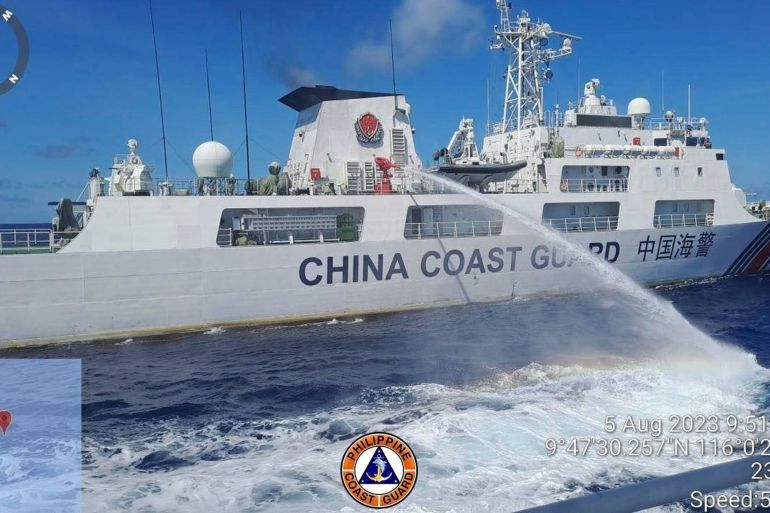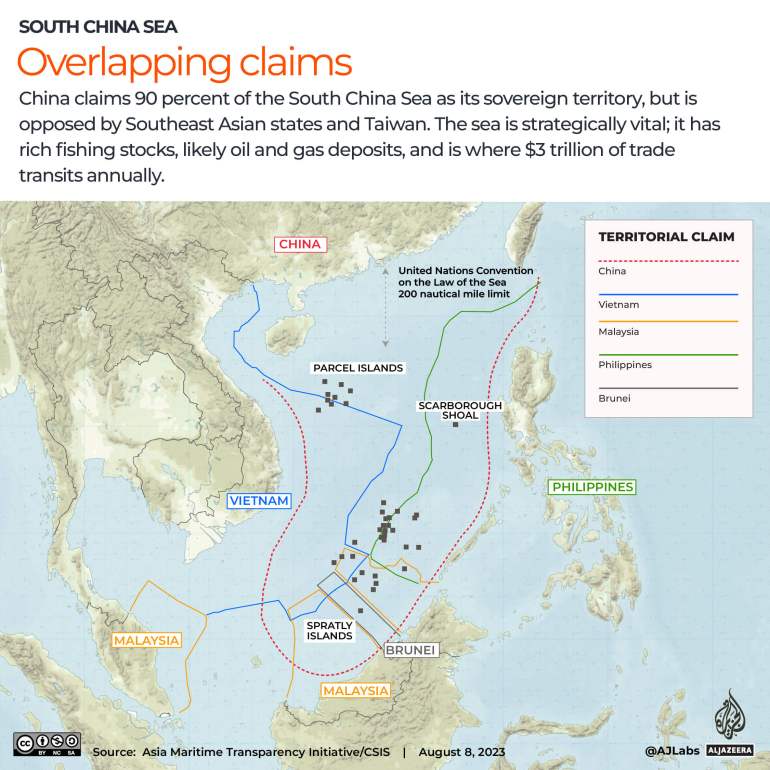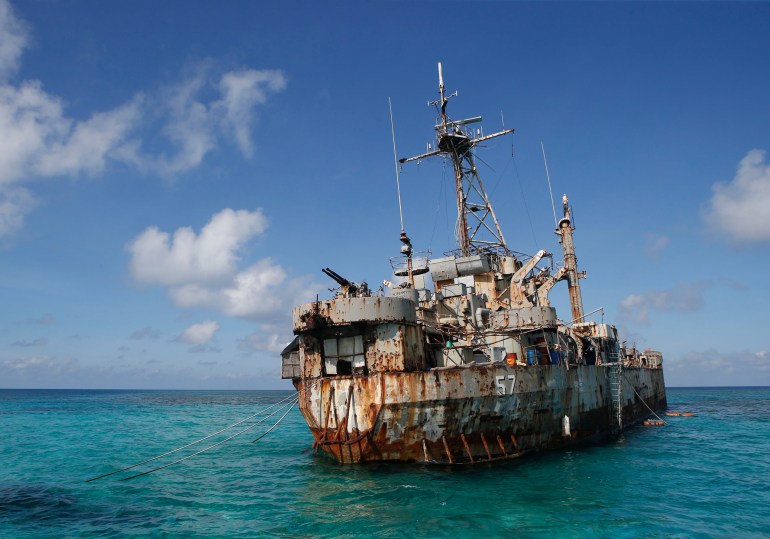What’s behind rising China-Philippines tensions in the South China Sea?
Here’s what you need to know as maritime confrontations between China and the Philippines increase.

Tensions between China and the Philippines are on the rise once again, with Manila accusing the Chinese Coast Guard of using water cannon to block a Philippine military supply boat from delivering food, fuel and water to troops garrisoned on a decommissioned warship grounded on a reef in the South China Sea.
The confrontation over the weekend – near the disputed Second Thomas Shoal – was the latest flare-up in a long-running territorial conflict in the resource-rich waters, involving China, the Philippines, Vietnam, Malaysia, Taiwan and Brunei.
Keep reading
list of 4 itemsUS deployed warships after China, Russia naval patrol near Alaska: WSJ
Philippines summons China envoy after water cannon incident in disputed sea
China accused of using water cannon on Philippine boat in South China Sea
Branding the Chinese Coast Guard’s actions “excessive” and “dangerous”, the Philippines summoned Beijing’s envoy in Manila to lodge a formal protest.
For its part, Beijing, which claims sovereignty over the submerged reef, known as Ayungin in the Philippines and Ren’ai in China, urged the Philippine military to remove the grounded ship from the area.
But Manila was defiant.
“The Philippines will never abandon our post in Ayungin Shoal,” a spokesman for the Philippine National Security Council said.
Beijing responded with a strong warning.
“China will continue to take necessary measures to safeguard its sovereignty,” the defence ministry said.
As the standoff between Beijing and Manila continues, here is what you need to know.
Whose territory is it, anyway?
- China claims sovereignty over nearly all of the South China Sea, including the Second Thomas Shoal, based on historical records dating to the Xia dynasty, nearly 4,000 years ago.
- Beijing has illustrated its claim to the critical maritime area – a key sea transport route – with a vague, U-shaped “nine-dash line” that cuts into the exclusive economic zones, or EEZs, of Brunei, Indonesia, Malaysia, the Philippines, Taiwan and Vietnam.
- China’s growing presence in the South China Sea began decades ago. Beijing seized the Paracel Islands from Vietnam in 1974 and took control of Mischief Reef in the Spratly Islands from the Philippines in 1995.
- But a tribunal at The Hague, based on a suit brought by the Philippines, ruled in 2016 that China had no “historic title” over the waters of the South China Sea and that its nine-dash line and historic claims were superseded by the 1982 United Nations Convention on the Law of the Sea.
- Beijing has ignored the ruling, however.

- Experts say China wants control of the South China Sea to dominate a major trade through which most of its imported oil flows.
- Control of the sea lane would allow China to potentially disrupt, or threaten to disrupt, cargo shipments travelling to and from all countries in East and Southeast Asia.
- China could also deny foreign military forces, particularly the United States’, access to the maritime region.
- Additionally, the South China Sea may contain massive oil and natural gas reserves beneath its seafloor.
- Sovereignty over the region could also give China a level of energy security and independence far beyond what it currently possesses.
- Since The Hague ruling, China has turned seven of the reefs it controls in the disputed waters into missile-protected military bases.
Why has the Philippine grounded a warship on a reef?
- The Philippines is among China’s most vocal challengers in the dispute.
- In 1999, the Philippines deliberately grounded a World War II-era warship at the Second Thomas Shoal in an effort to check China’s advance in the contested waters.
- The Second Thomas Shoal, located just 37.8km (23.4 miles) east of the Chinese-controlled Mischief Reef, is about 200km (124 miles) from the Philippine island of Palawan and more than 1,000km (621 miles) from China’s nearest major landmass of Hainan Island.
- The Philippine military stationed a handful of troops on the rusty warship, known as the BRP Sierra Madre.

- The troops stationed on BPS Sierra Madre depend on regular resupply missions to survive their remote assignment, but Manila says China’s coastguard routinely attempts to disrupt those operations. It also says Chinese vessels regularly block or shadow Philippine ships patrolling the waters.
- The number of reported confrontations with China appears on the rise this year, with the Philippines accusing a Chinese ship of carrying out “dangerous manoeuvres” against one of its vessels near the Second Thomas Shoal in July.
- Manila also alleged that the Chinese coastguard directed a military-grade laser at another ship, causing “temporary blindness” to its crew in February.
- China, for its part, claims it took action only against the vessels that intruded into its territorial waters.
What other actions have the Philippines taken?
- Amid the tensions, Philippine President Ferdinand Marcos Jr has said the main mission of its military – which has spent decades battling communists and groups linked to al-Qaeda – has changed to defending the country’s borders.
- In a break with his predecessor Rodrigo Duterte’s policy, Marcos has sought to bolster defence ties with the US.
- In February, the Marcos Jr government gave the US access to four more military bases under the 2014 Enhanced Defense Cooperation Agreement (EDCA), which allows for joint training between the US and the Philippines, prepositioning of equipment and the building of facilities such as runways, fuel storage and military housing.
- Those sites include locations facing the South China Sea as well as the self-governed island of Taiwan.
- For its part, the US has announced $100m in military aid to the Philippines, as well as $82m to upgrade the EDCA sites.
- In April, the two militaries held their largest-ever joint drills, that for the first time included live-fire exercises at sea.
- In May, following a summit between Marcos and US President Joe Biden, the Pentagon made an explicit commitment to defend the Philippines if it came under attack in the South China Sea.
- Analysts said the announcement was aimed at sending a warning to China.
- Beijing has criticised Manila’s decision to bolster ties with the US as one “that could drag the Philippines into the abyss of geopolitical strife”.
- China and the US have also clashed in the South China Sea and in the Strait of Taiwan.
- In June, the Pentagon accused a Chinese navy ship of carrying out “unsafe” manoeuvres near a US destroyer transiting the Taiwan Strait and in May, alleged that a Chinese fighter jet performed an “unnecessarily aggressive” move against one of its aircraft during a flight over the South China Sea.
- China has blamed “provocation” by the US for the security issues.